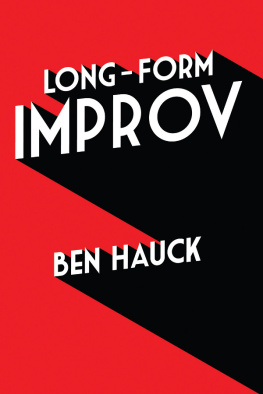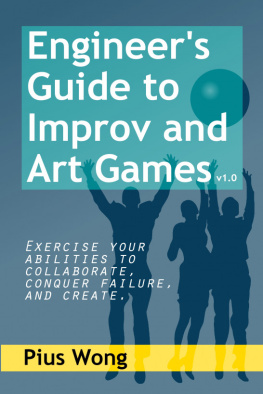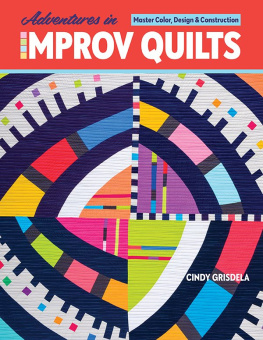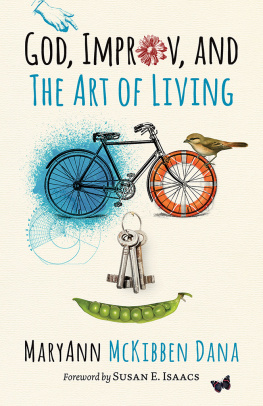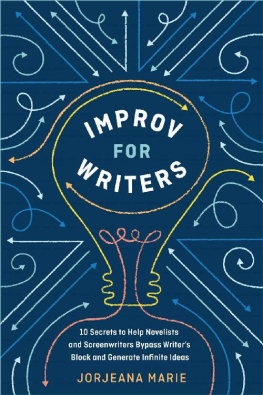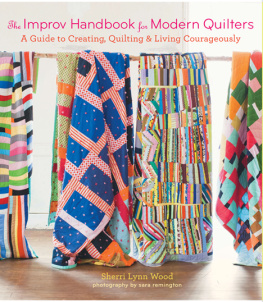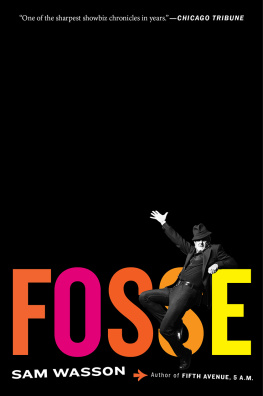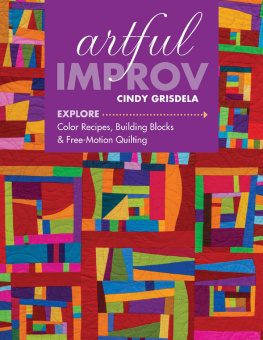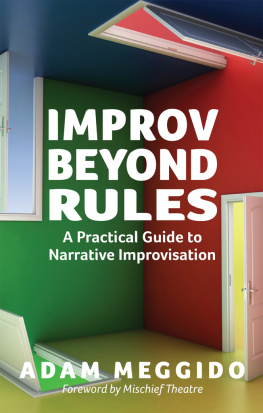Salinsky - The Improv Handbook
Here you can read online Salinsky - The Improv Handbook full text of the book (entire story) in english for free. Download pdf and epub, get meaning, cover and reviews about this ebook. year: 2008, publisher: Bloomsbury Publishing, genre: Home and family. Description of the work, (preface) as well as reviews are available. Best literature library LitArk.com created for fans of good reading and offers a wide selection of genres:
Romance novel
Science fiction
Adventure
Detective
Science
History
Home and family
Prose
Art
Politics
Computer
Non-fiction
Religion
Business
Children
Humor
Choose a favorite category and find really read worthwhile books. Enjoy immersion in the world of imagination, feel the emotions of the characters or learn something new for yourself, make an fascinating discovery.

- Book:The Improv Handbook
- Author:
- Publisher:Bloomsbury Publishing
- Genre:
- Year:2008
- Rating:3 / 5
- Favourites:Add to favourites
- Your mark:
- 60
- 1
- 2
- 3
- 4
- 5
The Improv Handbook: summary, description and annotation
We offer to read an annotation, description, summary or preface (depends on what the author of the book "The Improv Handbook" wrote himself). If you haven't found the necessary information about the book — write in the comments, we will try to find it.
The Improv Handbook — read online for free the complete book (whole text) full work
Below is the text of the book, divided by pages. System saving the place of the last page read, allows you to conveniently read the book "The Improv Handbook" online for free, without having to search again every time where you left off. Put a bookmark, and you can go to the page where you finished reading at any time.
Font size:
Interval:
Bookmark:
The Improv Handbook
The Ultimate Guide
to Improvising in Comedy,
Theatre, and Beyond
by TOM SALINSKY
and DEBORAH FRANCES-WHITE

Bloomsbury Methuen Drama
An imprint of Bloomsbury Publishing Inc
175 Fifth Avenue | 50 Bedford Square |
New York | London |
NY 10010 | WC1B 3DP |
USA | UK |
www.bloomsbury.com
First published by Continuum International Publishing Group 2008
Reprinted 2011 (twice), 2012
Reprinted by Bloomsbury Methuen Drama 2013
Tom Salinsky and Deborah Frances-White 2008
All rights reserved. No part of this publication may be reproduced or
transmitted in any form or by any means, electronic or mechanical,
including photocopying, recording, or any information storage or retrieval
system, without prior permission in writing from the publishers.
No responsibility for loss caused to any individual or organization
acting on or refraining from action as a result of the material in this
publication can be accepted by Bloomsbury or the author.
Visit www.bloomsbury.com to find out more about our authors and their books
You will find extracts, author interviews, author events and you can sign up for
newsletters to be the first to hear about our latest releases and special offers.
Library of Congress Cataloging-in-Publication Data
Salinsky, Tom.
The improv handbook : the ultimate guide to improvising in comedy, theatre, and
beyond / by Tom Salinsky and Deborah Frances-White.
p. cm.
Includes bibliographical references and index.
ISBN-13: 978-0-8264-2859-2 (hardcover : alk. paper)
ISBN-10: 0-8264-2859-2 (hardcover : alk. paper)
ISBN-13: 978-0-8264-2858-5 (pbk. : alk. paper)
ISBN-10: 0-8264-2858-4 (pbk. : alk. paper) 1. Improvisation (Acting)
I. Frances-White, Deborah. II. Title.
PN2071.I5S27 2008
792.028dc22
2008017480
eISBN-13: 978-1-4725-3662-4
For my parents
For Mother and Dad who
encouraged me in all my endeavors.
And for Patti Stiles,
our mother in improv.
What follows is a personal account of the state of the art of comedy improvisation. In writing this book, we have tried to serve two masters. On the one hand, we want to give as broad an overview as possible. We have tackled questions like: Where did improvisation come from? Where is it going? What is it good for? Who are the major leaders and how do they differ? Can you make money at it? How?
But, on the other hand, as practitioners of the art with over twenty years of experience between us, we have also formed some pretty strong opinions about what works and what doesnt, whats helpful and whats destructive, whats positive and whats negative. Our experience in improvisation has mainly been with the school of thought associated with Keith Johnstone and Calgary, although we have also made it our mission to go to Chicago and train with people associated with Del Closenotably Charna Halpernand Deborah is now an Artistic Associate of the Chicago Improv Festival. And this book also covers work influenced by Viola Spolin, ideas we have developed ourselves and some material that doesnt neatly fit into any of these categories. Does our longer experience with Keith make us biased? It depends on how you look at it. On the one hand, yes, we think that we have found a productive methodology and we acknowledge the enormous debt we owe to Keith in discovering that. On the other hand, we dont feel any particular intellectual loyalty to Keith, and will be happy to accept, use and steal ideas from anyone. Our mantra is simply: whatever works.
Our hope is that this personal viewpoint will be appealing and interesting. This book, for better or worse, is our account of what improvisation is, has been, will be and should be. It is shaped by our experiences and our history, and if we come across as opinionated, then we hope that you will be either overjoyed to have found like minds or stimulated by an opposing argument, or at least made pleasantly aggrieved to have found people you can entirely disagree with.
: How to Improvise. Before that, we will briefly look at What Is Improvisation? and after that we will look at How to Improvise in Public, How to Make Improvisation Pay and also hear from some of the current leading lights of the art form (Del Close and Viola Spolin are both sadly no longer with us).
Section Two is modeled on our improvisation workshops, which have been enormously popular since almost the day they began. We are tremendously pleased and proud to have trained hundreds of improvisers since then, and to have been invited to teach at British institutions such as The Actors Centre, RADA, The Central School of Speech and Drama and as guests of other improvisation companies the world over.
Improvisation has a tremendous power to liberate, inspire and enthusewhich is why we still love it after all these years. Agree or disagree, seasoned improviser or trembling neophyte, we hope this book is an enjoyable and stimulating read.
A glossary of terms is included at the back of the book, which may be helpful for those new to improvisation.
Tom Salinsky and Deborah Frances-White
October 2007
London
ONE
What Is Improvisation?
Overview
Where did improvisation come from, and who are the main and most influential practitioners today?
Almost any book on improvisation will tell you that improvised theatre began with the Commedia DellArteand for once, any book is right, although possibly not for the reasons supposed.
A moments thought about how theatre came to be will reveal that the notion of re-enacting events for an audience almost certainly came before the notion of writing a script to be memorized, but it is fair enough to not describe this kind of proto-theatre as improvised, despite the fact that it was necessarily re-created fresh at each performance.
As the writer, very swiftly, assumed dominance of the theatre, the script became of paramount importance. The reason for this is also clear to see, and applies not just to theatre, but to all temporal art forms. Mozart was thought to be an astonishing improviser, but it is only his premeditated music which remains, sinceby definitionhis improvisations were not recorded for posterity (although they may have inspired music which he later recorded). Scripts, books and music manuscripts can travel and endure in the way that a brief moment of inspiration cannot.
The Commedia DellArte arose in Italy in the fifteenth century and specialized in bawdy comedies built around stock situations and populated by stock characters, often played by actors who had played them for many years, or even decades. In contrast to almost all the theatre which preceded itat least from the ancient Greeks onthere was no definite script. Instead, Commedia DellArte performers were free to improvise around the familiar situations, creating extemporized comic set-pieces, dialogue exchanges and even plot details as the fancy took them. No doubt this was a highly successful methodology, as it endured well into the eighteenth century and its influence is still felt today. It surely
Next pageFont size:
Interval:
Bookmark:
Similar books «The Improv Handbook»
Look at similar books to The Improv Handbook. We have selected literature similar in name and meaning in the hope of providing readers with more options to find new, interesting, not yet read works.
Discussion, reviews of the book The Improv Handbook and just readers' own opinions. Leave your comments, write what you think about the work, its meaning or the main characters. Specify what exactly you liked and what you didn't like, and why you think so.

